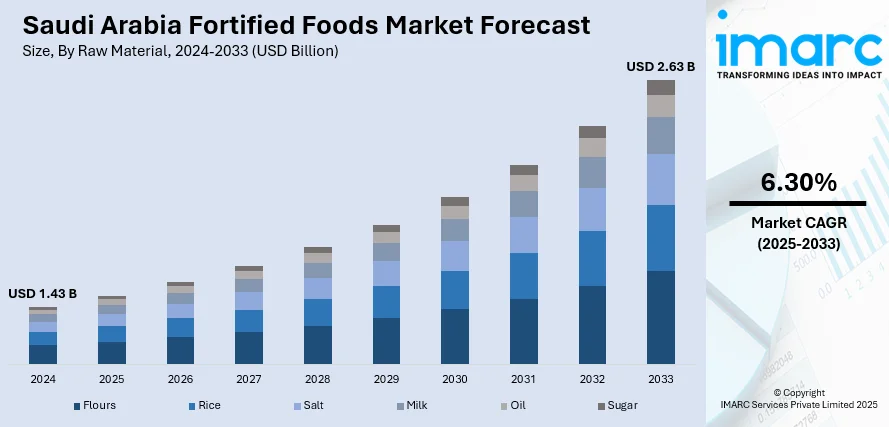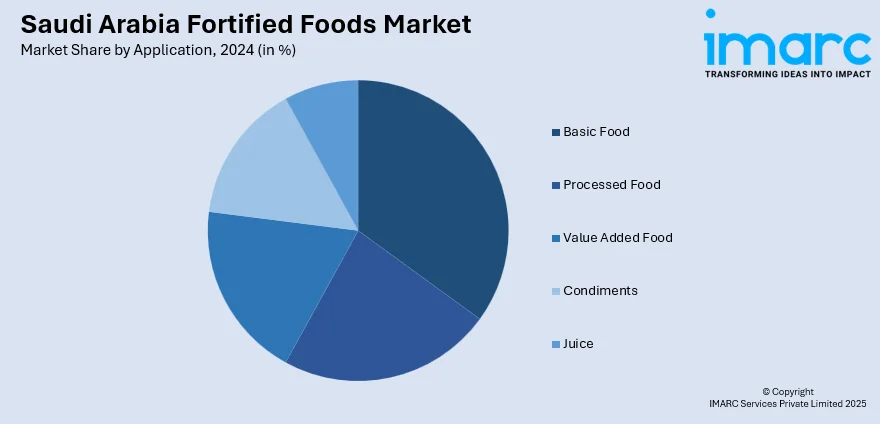
Saudi Arabia Fortified Foods Market Size, Share, Trends and Forecast by Raw Material, Micronutrient, Application, Technology, Sales Channel, and Region, 2025-2033
Saudi Arabia Fortified Foods Market Overview:
The Saudi Arabia fortified foods market size reached USD 1.43 Billion in 2024. Looking forward, IMARC Group expects the market to reach USD 2.63 Billion by 2033, exhibiting a growth rate (CAGR) of 6.30% during 2025-2033. The market is experiencing steady growth, driven by increasing health awareness and demand for nutrient-rich products. Rising consumer preference for functional foods that offer added health benefits, such as vitamins and minerals, is also fueling market expansion. The growth of the health-conscious population and evolving dietary trends are further contributing to Saudi Arabia fortified foods market share.
|
Report Attribute
|
Key Statistics
|
|---|---|
|
Base Year
|
2024
|
|
Forecast Years
|
2025-2033
|
|
Historical Years
|
2019-2024
|
| Market Size in 2024 | USD 1.43 Billion |
| Market Forecast in 2033 | USD 2.63 Billion |
| Market Growth Rate 2025-2033 | 6.30% |
Saudi Arabia Fortified Foods Market Trends:
Growing Health Consciousness
Health awareness is a key driving force in the Saudi Arabia fortified foods market, with consumers increasingly concerned with the role of nutrition in well-being. There is increased movement toward foods that provide extra health benefits, including fortified vitamins, minerals, and antioxidants, especially in relation to providing immunity boosts and long-term health support. As individuals make efforts to upgrade their diet and avoid lifestyle-related diseases, the market for fortified foods, including cereals, dairy products, and drinks, has boomed. Moreover, due to greater awareness of chronic disorders like obesity and heart ailments, the consumer is actively looking for foods that will lead to improved health. This trend is also backed by the growth of availability of fortified items in malls and hypermarkets and the rising popularity of healthy eating behavior, particularly among the young, educated cohorts of Saudi Arabia.

Rising Demand for Functional Foods
Saudi Arabia fortified foods market is witnessing growth in demand for functional foods, which provide added nutritional value beyond mere nourishment. The consumers are seeking more products supplemented with vital vitamins, minerals, and probiotics to keep their bodies healthy and avoid any deficiencies. These functional foods aim to fulfil specific requirements, such as immune system enhancement, gut health improvement, and overall heart health. As consciousness regarding preventive healthcare increases, foods such as fortified cereals, dairy, juices, and snacks are increasingly being consumed. Probiotics, which have positive effects on the stomach, are especially sought after as consumers seek out gut-friendly foods to enhance well-being. The increasing trend towards health-aware consumption patterns, combined with the widening range of functional foods presented in the Saudi market, indicates growing interest in foods that provide not just nutrition but also medication, making functional foods an important market segment in Saudi Arabia.
Increasing Government Support
The Saudi Arabian government is increasingly focusing on addressing nutritional deficiencies within the population through the promotion of fortified foods. As part of its health and wellness initiatives, the government has been encouraging food manufacturers to fortify staple foods with essential vitamins and minerals, such as Vitamin D, iron, and folic acid, to combat widespread deficiencies. These efforts are in line with the country’s Vision 2030, which emphasizes improving public health and reducing the burden of lifestyle diseases. Regulatory frameworks have been implemented to ensure the safety and efficacy of fortified foods, and there are also incentives for companies that invest in fortification. Additionally, the government is educating the public on the benefits of fortified foods as a cost-effective means to improve nutrition. These supportive measures are fueling the Saudi Arabia fortified foods market growth.
Saudi Arabia Fortified Foods Market Segmentation:
IMARC Group provides an analysis of the key trends in each segment of the market, along with forecasts at the country and regional levels for 2025-2033. Our report has categorized the market based on raw material, micronutrient, application, technology, and sales channel.
Raw Material Insights:
- Flours
- Rice Flour
- Wheat Flour
- Corn Flour
- Rice
- Salt
- Milk
- Oil
- Sugar
The report has provided a detailed breakup and analysis of the market based on the raw material. This includes flours (rice flour, wheat flour, and corn flour), rice, salt, milk, oil, and sugar.
Micronutrient Insights:
- Vitamins
- Vitamin A
- Vitamin B
- Vitamin C
- Vitamin D
- Others
- Minerals
- Calcium
- Iron
- Zinc
- Iodine
- Others
- Other Fortifying Nutrients
A detailed breakup and analysis of the market based on the micronutrient have also been provided in the report. This includes vitamins (A, B, C, D, and others), minerals (calcium, iron, zinc, iodine, and others), and other fortifying nutrients.
Application Insights:

- Basic Food
- Cheese
- Butter
- Yogurt
- Others
- Processed Food
- Extruded Products
- Powdered Products
- Value Added Food
- Condiments
- Juice
A detailed breakup and analysis of the market based on the application have also been provided in the report. This includes basic food (cheese, butter, yogurt, and others), processed food (extruded products and powdered products), value added food, condiments, and juice.
Technology Insights:
- Drying
- Oven Drying
- Drum Drying
- Spray Drying
- Extrusion
- Coating and Encapsulation
- Others
A detailed breakup and analysis of the market based on the technology have also been provided in the report. This includes drying (oven, drum, and spray), extrusion, coating and encapsulation, and others.
Sales Channel Insights:
- Modern Trade
- Online Sales
- Neighborhood Stores
- Others
A detailed breakup and analysis of the market based on the sales channel have also been provided in the report. This includes modern trade, online sales, neighborhood stores, and others.
Regional Insights:
- Northern and Central Region
- Western Region
- Eastern Region
- Southern Region
The report has also provided a comprehensive analysis of all the major regional markets, which include Northern and Central Region, Western Region, Eastern Region, and Southern Region.
Competitive Landscape:
The market research report has also provided a comprehensive analysis of the competitive landscape. Competitive analysis such as market structure, key player positioning, top winning strategies, competitive dashboard, and company evaluation quadrant has been covered in the report. Also, detailed profiles of all major companies have been provided.
Saudi Arabia Fortified Foods Market News:
- In March 2025, iPRO officially launched its healthy hydration products in Saudi Arabia through a partnership with Al Rabie. This collaboration aims to promote health-conscious options in the Kingdom, featuring unique formulations with natural ingredients and vitamins. iPRO Hydrate is now available at over 21,000 sales points across the country.
- In March 2023, Tanmiah Food Company launched Omega-3 fortified chicken, the first of its kind in Saudi Arabia, under its Tanmiah Life sub-brand. This innovative product offers health benefits, including essential Omega-3 fatty acids, catering to the growing demand for healthy, halal protein options.
Saudi Arabia Fortified Foods Market Report Coverage:
| Report Features | Details |
|---|---|
| Base Year of the Analysis | 2024 |
| Historical Period | 2019-2024 |
| Forecast Period | 2025-2033 |
| Units | Billion USD |
| Scope of the Report |
Exploration of Historical Trends and Market Outlook, Industry Catalysts and Challenges, Segment-Wise Historical and Future Market Assessment:
|
| Raw Materials Covered |
|
| Micronutrients Covered |
|
| Applications Covered |
|
| Technologies Covered |
|
| Sales Channels Covered | Modern Trade, Online Sales, Neighborhood Stores, Others |
| Regions Covered | Northern and Central Region, Western Region, Eastern Region, Southern Region |
| Customization Scope | 10% Free Customization |
| Post-Sale Analyst Support | 10-12 Weeks |
| Delivery Format | PDF and Excel through Email (We can also provide the editable version of the report in PPT/Word format on special request) |
Key Questions Answered in This Report:
- How has the Saudi Arabia fortified foods market performed so far and how will it perform in the coming years?
- What is the breakup of the Saudi Arabia fortified foods market on the basis of raw material?
- What is the breakup of the Saudi Arabia fortified foods market on the basis of micronutrient?
- What is the breakup of the Saudi Arabia fortified foods market on the basis of application?
- What is the breakup of the Saudi Arabia fortified foods market on the basis of technology?
- What is the breakup of the Saudi Arabia fortified foods market on the basis of sales channel?
- What is the breakup of the Saudi Arabia fortified foods market on the basis of region?
- What are the various stages in the value chain of the Saudi Arabia fortified foods market?
- What are the key driving factors and challenges in the Saudi Arabia fortified foods market?
- What is the structure of the Saudi Arabia fortified foods market and who are the key players?
- What is the degree of competition in the Saudi Arabia fortified foods market?
Key Benefits for Stakeholders:
- IMARC’s industry report offers a comprehensive quantitative analysis of various market segments, historical and current market trends, market forecasts, and dynamics of the Saudi Arabia fortified foods market from 2019-2033.
- The research report provides the latest information on the market drivers, challenges, and opportunities in the Saudi Arabia fortified foods market.
- Porter's five forces analysis assist stakeholders in assessing the impact of new entrants, competitive rivalry, supplier power, buyer power, and the threat of substitution. It helps stakeholders to analyze the level of competition within the Saudi Arabia fortified foods industry and its attractiveness.
- Competitive landscape allows stakeholders to understand their competitive environment and provides an insight into the current positions of key players in the market.
Need more help?
- Speak to our experienced analysts for insights on the current market scenarios.
- Include additional segments and countries to customize the report as per your requirement.
- Gain an unparalleled competitive advantage in your domain by understanding how to utilize the report and positively impacting your operations and revenue.
- For further assistance, please connect with our analysts.
 Request Customization
Request Customization
 Speak to an Analyst
Speak to an Analyst
 Request Brochure
Request Brochure
 Inquire Before Buying
Inquire Before Buying




.webp)




.webp)












